One to one maths interventions built for KS4 success
Weekly online one to one GCSE maths revision lessons now available
This topic is relevant for:

Number – Maths GCSE
Here we will learn about GCSE number, including place value, arithmetic, factors, multiples, primes and many other number topics.
There are also GCSE number worksheets based on Edexcel, AQA and OCR exam questions, along with further guidance on where to go next if you’re still stuck.
What is number?
Number is one of the topic areas of GCSE mathematics that features across all of the other areas of mathematics. You will need to be confident with all of the number topics to be able to solve problems involving algebra, ratio, geometry, statistics and probability.
You will also be asked questions that are purely number problems involving topics such as factors and multiples, prime numbers, indices, rounding or arithmetic.
In this page we will link to lots of other pages that will help with a variety of number topics. Let’s look at some of the different ways your number skills could be assessed in GCSE Mathematics.
What is number?
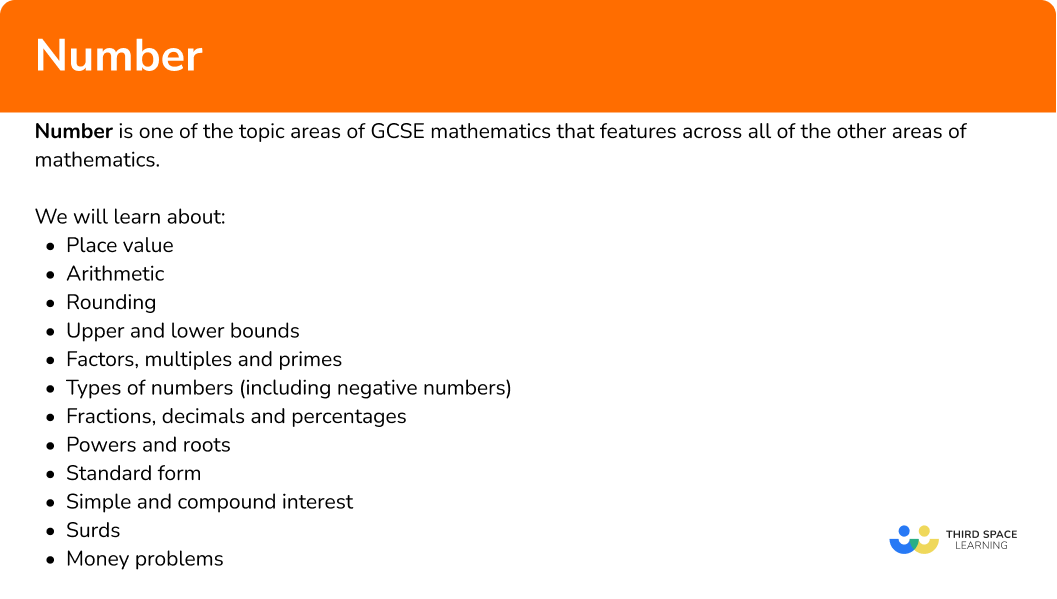

GCSE number worksheets

Over 75 GCSE number worksheets ready to download and give to your GCSE students. Each with functional and applied reasoning questions and exam style questions.
DOWNLOAD FREE
GCSE number worksheets

Over 75 GCSE number worksheets ready to download and give to your GCSE students. Each with functional and applied reasoning questions and exam style questions.
DOWNLOAD FREEPlace value
Place value is the value of each digit within a number.
A number is made up of digits. We need to be able to identify the location of each digit within the number as this can help to understand how large or small the number is.
To determine the value of a digit within a number we label each column with a title, like this,
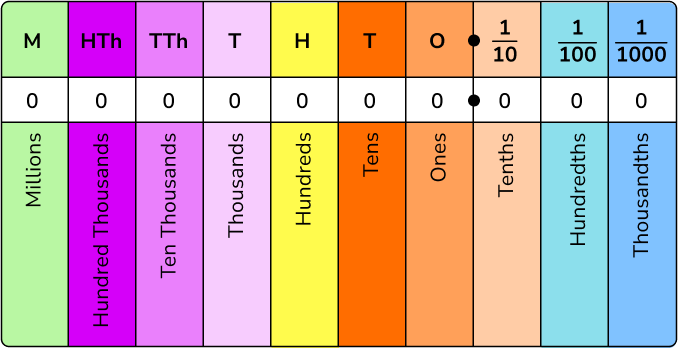
For example,
Write down the value of the digit in the number
- Locate the digit within the number.
⬆
2Recall the place value of that column.
The is in the tenths column.
3Write the value of the digit.
The value of the digit in the number is five tenths, or
Step-by-step guide: Place value
Arithmetic
Arithmetic is the study of numbers and the operations between them.
To use arithmetic with positive and negative numbers, we need to be able to calculate using the four main operations.

For example,
A group of young people are donating money to some charities. Altogether they collect which will be split equally between three charities. How much does each charity receive?
- Determine which operator you need to use.
We need to divide by
2Carry out the calculation.
Use a method of division such as short division.

Each charity receives
Step-by-step guide: Arithmetic
Rounding numbers
Rounding is when we approximate numbers in order to make them easier to deal with. We need to round down or up depending on which value is nearer. There are several ways we can be asked to round a number.
For example,
can be rounded in several ways, including the below methods.
Step-by-step guide: Rounding numbers
- Rounding to the nearest ones place, and
is rounded to the nearest
Step-by-step guide: Rounding to the nearest 10, 100 and 1000
- Rounding to decimal places
is rounded to decimal place (the nearest tenth).
Step-by-step guide: Rounding decimals (coming soon)
- Rounding to significant figures
is rounded to significant figure.
Step-by-step guide: Significant figures
- Truncation is cutting a number off at a certain value with no need to round up.
Truncating a number is also linked with rounding.
is truncated to decimal place.
Step-by-step guide: Truncation
- Estimation is using the approximated numbers for a calculation; we do not use the exact numbers.
Estimation is also linked with rounding.
is rounded to decimal place.
To estimate the answer to we would calculate to get an estimate of
Step-by-step guide: Estimation
Upper and lower bounds
Upper and lower bounds are the maximum and minimum values that a number could have been before it was rounded. They can also be called limits of accuracy.
We need to be able to find upper and lower bounds of rounded numbers and use them in calculations. To do this we think about what the smallest and biggest numbers that round to a value for a given degree of accuracy are and then use the correct values for the calculation required.
We can display the upper and lower bounds using error intervals.
For example,
A number has been rounded to decimal place and given as
The smallest number that will round up to is and any number up to will round down to
Therefore we can write,
We have to use for the upper bound as would round up to not down to
However, any number up to would round down to (for example This is why we write as the upper bound.
Step-by-step guide: Upper and lower bounds
Factors, multiples and primes
Factors, multiples and primes are different types of numbers.
In GCSE mathematics you may need to use factors, multiples and primes to solve problems. These may involve the following.
Step-by-step guide: Factors, multiples and primes
- Factors
A factor is a number which divides into another number exactly with no remainders.
For example, the factors of are and
Step-by-step guide: Factors
- Multiples
A multiple of a number is a number in its times table.
For example, the first multiples of are and
Step-by-step guide: Multiples
- Primes
A prime number is a number that only has two factors, and itself.
For example, the first prime numbers are and
Step-by-step guide: Prime numbers
- Prime factors
Prime factors are factors of a number that are also prime numbers.
For example, the prime factors of are and
can be written as a product of its prime factors,
Step-by-step guide: Prime factors
- Lowest common multiple
The lowest common multiple (LCM) of two numbers is the lowest value that is a multiple of each number.
For example, the lowest common multiple of and is
Step-by-step guide: Lowest common multiple
- Highest common factor
The highest common factor (HCF) of two numbers is the highest value that is a factor of each number.
For example, the highest common factor of and is
Step-by-step guide: Highest common factor
Negative numbers
Negative numbers are any numbers less than zero. They have a negative or minus sign in front of them. Numbers greater than zero are referred to as positive numbers. If there is no sign in front of a number the number is positive.
On the number line below we can see some positive and negative integers (whole numbers).

The numbers in orange are negative values and the blue numbers are positive values.
Zero is neither positive nor negative.
Just like you can add, subtract, multiply and divide positive numbers, you can do the same with negative numbers whether they are integers, decimals or fractions.
When adding and subtracting negative numbers we need to remember some rules.
If the signs are the same, replace them with a positive sign.
If the signs are different, replace them with a negative sign.
The chart below summarises this.
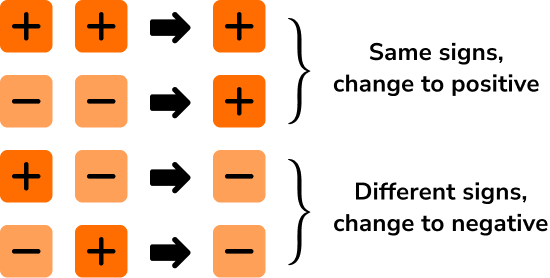
As a rule of thumb – same signs add, different signs subtract.
For example,
When multiplying and dividing negative numbers we need to remember some rules.
If the signs are the same, the answer is positive.
If the signs are different, the answer is negative.
When multiplying negative numbers,
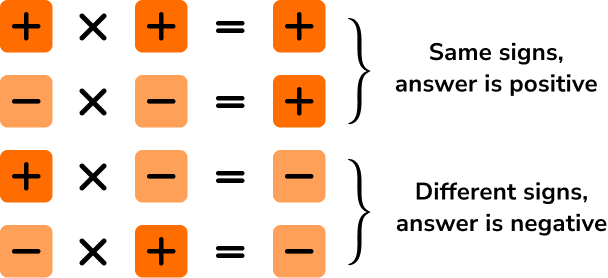
The same rules apply for dividing negative numbers.
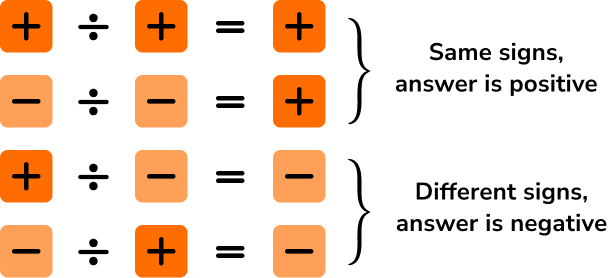
For example,
Step-by-step guide: Negative numbers
Fractions, decimals and percentages
Fractions, decimals and percentages are different ways of representing a proportion of the same amount. There is equivalence between fractions, decimals and percentages.
For example,
There are various methods of using fractions, decimals and percentages. They are important to understand as they are used in everyday life.
To succeed in GCSE mathematics you will need to be familiar with the following fraction, decimal and percentage topics,
- Adding and subtracting fractions
- Multiplying and dividing fractions
- Equivalent fractions, improper fractions and mixed numbers
- Ordering fractions
- Fractions of an amount
- Adding and subtracting decimals
- Multiplying and dividing decimals
- Percentage of an amount
- Percentage multipliers
- Percentage increase and decrease
- Percentage change
- Reverse percentages
- Converting and comparing fractions, decimals and percentages
Step-by-step guide: Fractions, decimals and percentages
- Fractions
Fractions are a way of writing equal parts of one whole.
There are two parts to a fraction, a numerator (top number) and a denominator (bottom number). The denominator shows how many equal parts the whole has been divided into. The numerator shows how many of the equal parts we have.
For example,
This shape has equal parts and of them are shaded.
This represents four ninths.
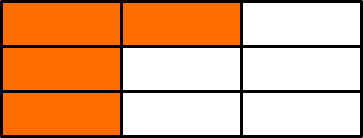
Step-by-step guide: Fractions
- Decimals
Decimals are a way of writing numbers that are not whole.
For example,
This shows the fraction

can also be written as .
Decimal numbers can be recognised as they have a decimal point.
A decimal place is a position after the decimal point.
For example,
has two decimal places.
There is a in the tenths place and in the hundredths place.
Step-by-step guide: Decimals
- Percentages
Percentages are numbers which are expressed as parts of
Percent means “number of parts per hundred” and the symbol we use for this is the percent sign
For example,
There are equal parts and of them are shaded.
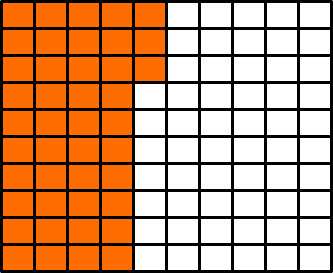
Step-by-step guide: Percentages
Powers and roots
Power and roots are terms that express a repeated multiplication of a number.
- Powers
For example,
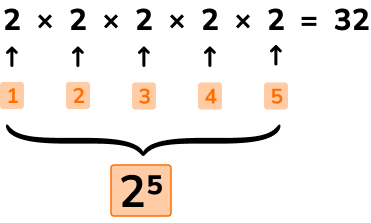
We say this as to the power of because the number is being multiplied by itself times.
- Roots
For example,

As we can say that the root of is
Step-by-step guide: Powers and roots
In GCSE mathematics you will need to be familiar with the following.
- Negative powers
When a number is raised to a negative power, we calculate the positive reciprocal of that number.
For example,
Step-by-step guide: Negative powers
- Fractional powers
Fractional powers are a type of index that represents the nth root of a number.
For example,
Step-by-step guide: Fractional powers
- Expressing a power with a different base
We can sometimes express a power with a different base in order to help to simplify expressions.
For example,
Step-by-step guide: Expressing power with a different base (coming soon)
- The laws of indices
Powers and roots are used in the five laws of indices,
| Multiplying | To multiply two powers with the same base, add the indices. | |
| Dividing | To divide two powers with the same base, subtract the indices. | |
| Brackets | To raise one power to another power, multiply the indices. | |
| Fractions | To raise a base to a fraction calculate the nth root of the base, raised to the power | |
| Negatives | To raise a base to a negative number, take the positive power of the reciprocal. |
Step-by-step guide: Laws of indices
Standard form
Standard form is a way of writing very large or very small numbers by using powers of ten. It is also known as scientific notation.
Numbers in standard form are written in this format,
.
Where is a number and is an integer.
To write a number in standard form we need to understand the place value of the number.
For example,
Let’s look at the number and write the digits in a place value table.
So, written in standard form is
.
In GCSE mathematics you will be expected to convert between ordinary numbers and standard form as well as perform calculations with numbers in standard form with and without a calculator.
For example,
Calculate .
Write your answer in standard form.
- Multiply the non-zero digits.
2Multiply the powers of ten by adding the powers.
3Put these two parts together and check whether the answer is in standard form.
This number is not in standard form as is not between and
To convert to a decimal between and you need to divide it by To maintain the value of the number, you need to multiply the power of ten by which adds one to the exponent.
Step-by-step guide: Standard form
Simple interest and compound interest
Simple and compound interest are two ways of calculating interest.
Simple interest is calculated on the original (principal) amount, whereas compound interest is calculated on the original amount and on the interest already accumulated on it.
The difference between simple and compound interest is that simple interest is calculated using only the original amount whereas compound interest works out the interest on a previous amount as well.
Check out the comparative example below to see the similarities and differences between the two forms of interest.
is invested for years at per year. Find the final value.
Simple interest
Here:
- (as % = )
Substituting these values into the simple interest formula
We get:
Compound interest
Here:
Substituting these values into the compound interest formula
We get:
x
As well as compound interest, you will also need to be able to work out compound depreciation. When the value of an asset reduces in price, it is known as depreciation.
Depreciation can be calculated the same way as compound interest but we must remember that the multiplier being used will be less than
For example,
A car worth depreciates by per year for years.
To find the value after years we calculate using the multiplier of
The car will be worth
Step-by-step guide: Simple interest and compound interest
Types of numbers
Types of numbers are different sets of numerical values.
You should already be familiar with odd and even numbers, as well as positive and negative numbers, whole numbers (integers) and decimals.
You should also be familiar with other sets of numbers including square and cube numbers, prime numbers, and triangular numbers.
Below is a description of each of these types of numbers, along with a few examples.
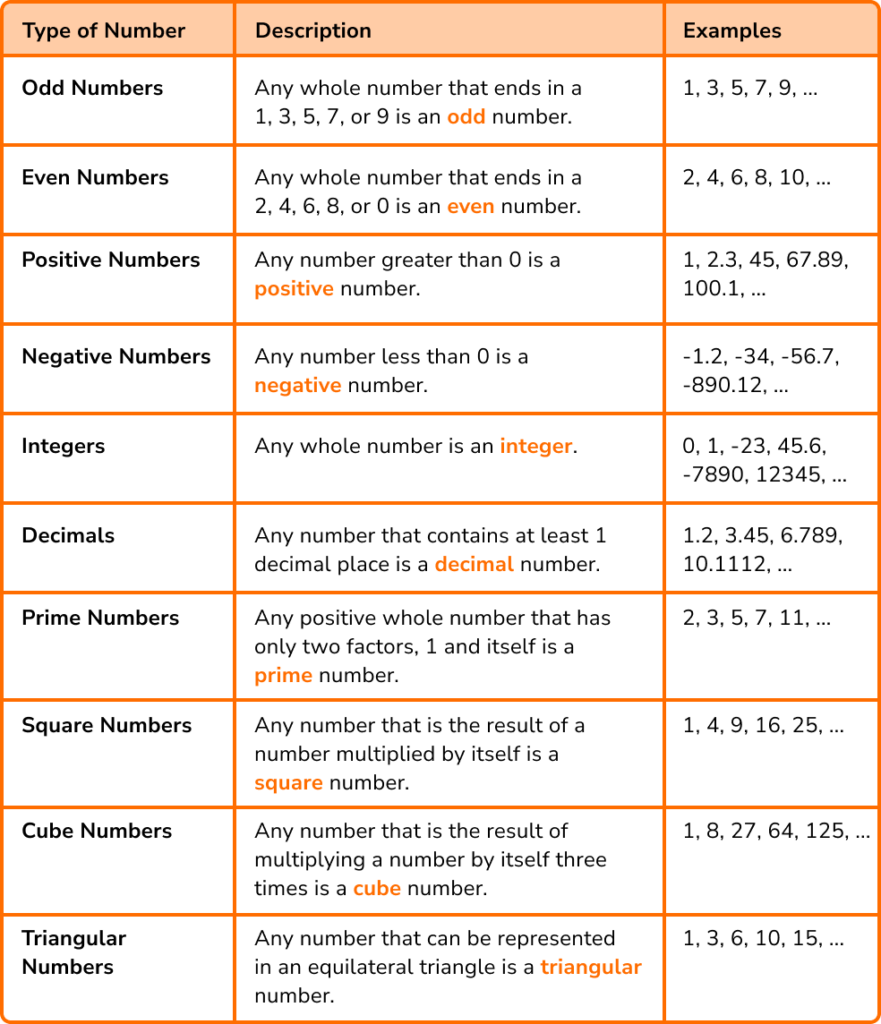
Step-by-step guide: Types of numbers
Surds
Surds are a root that gives an irrational number. An irrational number can’t be written as a fraction, and in decimal form is infinitely long with no recurring pattern.
For example,
which is an irrational number.
The square root of is a surd.
In GCSE mathematics you need to be able to use surds in calculations without a calculator. You will need to be able to do the following.
You will also be expected to expand brackets involving surds and use surds in other algebra and geometry problems.
Step-by-step guide: Surds
Money problems
Money problems are types of questions that involve finance. Examples could include,
- Best buys
- Using exchange rates
- Budgeting for a holiday
- Calculating the amount spent on a shopping trip
To be able to solve money problems in GCSE mathematics you will need to be confident with decimal arithmetic and rounding.
When calculating with money it will be important to leave answers to two decimal places if the answer is in pounds,
For example,
A pack of rolls of toilet paper costs A pack of toilet rolls costs
How much is the cheapest price for toilet rolls?
We need to multiply the cost of rolls by and multiply the cost of rolls by
The cheapest price for rolls of toilet paper is
Step-by-step guide: Money problems maths
Calculator skills
Calculator skills are important for the GCSE mathematics calculator papers and will help you later in life in many careers.
You may be asked to perform calculations involving powers and roots, fractions and trigonometric functions.
For example,
Work out write down all the numbers on your calculator display.
Step-by-step guide: Calculator skills
Common misconceptions
- Sometimes we need a zero in as a place holder when rounding with decimal numbers
Round to decimal places will be We need the zero in the hundredths column. So, we round up.
- Upper bound is incorrect
It is very common for students to put an incorrect upper bound.
For example, if a length has been rounded to to the nearest they may write the upper bound as The upper bound must be bigger than as also rounds down to so does The upper bound in this case is
- and prime numbers
is not a prime number. This is because it only has one factor, rather than the factors needed to be a prime number.
- Factors and multiples
Factors and multiples are easily mixed up. Remember multiples are the multiplication table, whereas factors are the numbers that go into another number without a remainder.
- Raising a negative number to a power greater than one
Remember when raising a negative number to a power greater than the resulting answer could be positive or negative. When you raise a negative number to an odd exponent the resulting answer is negative, when you raise a negative number to an even exponent the resulting answer is positive.
- Raising a number to a negative power
A common error is thinking that raising a number to a negative power makes the answer negative.
For example, the value of is sometimes incorrectly given as
The correct answer is as the negative power gives the reciprocal to the base number.
Practice number questions
1. Round to significant figures.




We are rounding to significant figures. The first significant figure is The in the ten thousandths column indicates we round the up.
2. Two boxes of height measured to the nearest millimetre, are stacked on top of each other. Find the upper and lower bounds of the combined height.
Upper bound lower bound

Upper bound lower bound

Upper bound lower bound

Upper bound lower bound

The error interval of the height, is
By adding the lower bounds for the height, we find the lower bound for the combined height.
By adding the upper bounds for the height, we find the upper bound for the combined height.
3. Find the lowest common multiple of and




Write down the multiples of and the multiples of and see which is the lowest number that occurs in both lists.
Multiples of :
Multiples of :
So, is the LCM of and
Alternatively you can use prime factorisation and Venn diagrams.
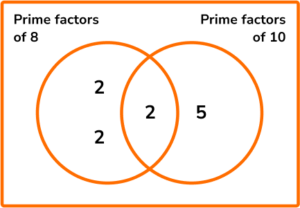
4. of a number is
What is the original number?




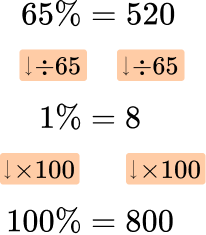
5. Evaluate .




6. Expand and simplify, .




Simplify
So the final answer is
GCSE number questions
1. Work out an estimate for
(3 marks)
Rounding one original number to significant figure or or
(1)
Calculation involving all three rounded numbers.
(1)
(1)
2. (a) Find the highest common factor of and
(b) Two buses leave the depot at
Bus A takes minutes to complete its journey and return to the depot.
Bus B takes minutes to complete its journey and return to the depot.
What time is it when both buses are back at the depot together?
(5 marks)
(a)
List of factors or prime factor decomposition of one or both.
(1)
HCF of .
(1)
(b)
Prime factorisation or list of multiples of one or both.
(1)
LCM of minutes.
(1)
or
(1)
3. (a) Expand and simplify
(b) Hence, or otherwise, show that can be written as
(5 marks)
(a)
Any two correct terms, .
(1)
All four correct terms, .
(1)
Simplified to .
(1)
(b)
(1)
leading to as required
(1)
The most popular lessons are
Still stuck?
Prepare your KS4 students for maths GCSEs success with Third Space Learning. Weekly online one to one GCSE maths revision lessons delivered by expert maths tutors.

Find out more about our GCSE maths tuition programme.
